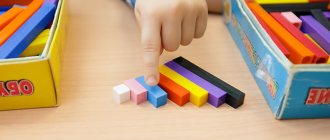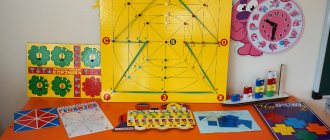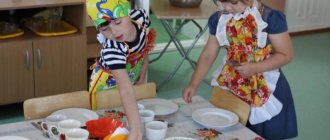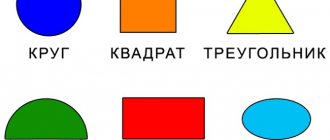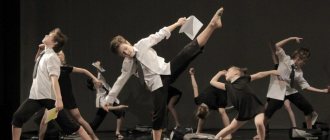There is a good joke. “Can you play the violin?” - “I don’t know, I haven’t tried it.” Is it possible to talk about Voskobovich’s educational games without the games themselves? Yes and no. To understand the game, you have to PLAY it. On the other hand, you need to understand IN THE NAME OF WHAT you need to play it.
Each phenomenon is based on either a theoretical proposition, which is then tested in practice (for example, a Waldorf garden), or practical experience, which is subsequently clothed in theory (for example, Nikitin).
The games that we will talk about today are definitely a movement from practice. But first, a little history.
In the beginning there were... children
The impetus for the invention of games was our own children. Here’s how Vyacheslav Voskobovich himself talks about it: “The era of perestroika. These are difficult times, but interesting in their own way. What was behind you by that time? Higher education – engineer-physicist. Passionate hobby: original song (wrote poetry, music, performed in concerts). A lyrical physicist, in a word. But children appear, and I turn into a normal, average parent. “I care” about the intellectual and creative health of my children. Shopping around toy stores makes you sad. There are games that our grandmothers' grandmothers played. And there is publicity around, all sorts of talk about alternative pedagogy. Fate brought us (how? – a separate topic) to these very “alternatives”, and off we went. Lectures, courses, lesson viewings, video materials. It would seem that after everything you have seen, heard, felt, take it (in those days this meant make it, today go and buy it) and use it. But I wanted to bring something of my own. And he brought it to such an extent that, in the end, it became a matter of life.”
How to use the toy
The Voskobovich square is a funny thing even for parents. In some ways it resembles origami, in some ways it resembles paper clamshell toys from our childhood. You can watch a master class on the Internet on the topic of using the toy, but I suggest using your own imagination first. So what can you do with a square?
- Try to count all triangles (even compound ones), as well as squares and rectangles. You will be surprised, but this is a really exciting activity.
- Try intuitive additions. Show your child how to fold a square to make a house, candy, triangle or small square, and then let the child try to fold something himself.
- Use different patterns to assemble ready-made square figures.
- Offer your child a game to develop their imagination - a banal guessing game. Take turns making some figures out of the square so that the other person can guess what happened.
- Be sure to invite your child to add up any symbols or letters that are familiar to him.
As soon as the toy becomes clear, it immediately turns into a favorite. Use recognizable elements to develop your baby's interest.
Voskobovich's first games
The first benefits appeared in the early 90s. The game “Geokont”, “Game Square” (now it is Voskobovich Square), “Folds”, “Color Clock” immediately attracted attention. By that time, Vyacheslav Voskobovich’s gaming practice was not limited only to the family; for several years he led children’s groups in educational games and literacy training.
With games and experience, they began to invite me to seminars. From the beginning in his native Leningrad, then to other cities.
There were more and more games - “Transparent Square”, “Transparent Number”, “Dominoes”, “Multiplication Planet”, the “Miracle Puzzles” series, “Math Baskets”... The first methodological fairy tales appeared.
Recommendations by age
Games and manuals are accompanied by descriptions indicating the recommended age. In practice, the same item can be used for an entire period of 2 to 7 years.
If a spider with a web of rubber bands teaches a two-year-old child the concept of colors and more or less, tones on the same basis, when preparing for school, the child can collect figures according to the abbreviation conceived by the teacher (route map) or solve the problem of inscribing an isosceles triangle into a square.
It all depends on the fairy tale proposed by the presenter. Even when using the same instrument in a group, you can change the difficulty of the lessons, going through the levels like in a computer game. The desire to reach the end or score extra points will be an additional incentive.
Where did you get all this from?
I remember a funny incident of that time that happened in one of the kindergartens in Leningrad. Vyacheslav Voskobovich demonstrates to the manager his then “arsenal” of games. She likes everything, and she begins to offer her own options, “trying out” games for her children. And suddenly he asks the author-inventor: “Where did you get all this?” Vyacheslav Vadimovich was a little confused and couldn’t find anything better than to raise his finger up. As if to say: from there, from above, illumination, they say. The manager reacted to this in her own way. In a serious voice, she clarified: “From RONO?”
Jokes aside, but according to a survey by the St. Petersburg Education Committee, already in 1997, 90% of the city’s preschool institutions used Voskobovich’s educational games in their work.
Game Features
The period before 1998 can be called differently: constructive, exploratory, amateur, intuitive. Something else is important. During this period, the basic principles of building games were laid down, which can still be traced today. So, what is so interesting about Voskobovich’s games?
1. Structural elements.
In “Geokont” there is a dynamic “elastic band” as a means of construction, in “Voskobovich Square” there is rigidity and flexibility at the same time, in “Transparent Square” there is a transparent plate with an opaque part, in “Cord-entertainer” there is a cord and a block, etc. .
2. Wide age range of game participants.
The same game attracts children both three and seven years old, and sometimes even high school students. This is possible because it contains one- or two-step exercises for little ones and complex multi-step tasks for older children.
3. Multifunctionality.
With one game you can solve a large number of educational problems. Unnoticed by yourself, the baby masters numbers and letters; recognizes and remembers color, shape; trains fine motor skills of the hands; improves speech, thinking, attention, memory, imagination.
4. Versatility in relation to programs.
“Childhood”, “Development”, “Rainbow”... As practice has shown, games fit perfectly into these and other programs of educational institutions.
5. Creative potential.
Do you remember which game your child plays with the longest? Of course, with the one that gives him the opportunity to turn his “ideas” into reality. How many interesting things can be invented and made from the details of “Miracle Puzzles”, multi-colored “webs” of “Geokont”, “eternal origami” of “Voskobovich Square”: cars, planes, ships, butterflies and birds, knights and princesses - a whole fairy-tale world! Games give adults the opportunity to be creative.
6. Fairytale cut.
They say a good diamond requires cutting. Why not give the game a fairy-tale edge, for example? Children's interest in fairy tales is both an additional motivation and a model of mediated learning. Children enjoy playing not with squares, triangles and trapezoids, but with the Non-melting Ice of Lake Ice and the multi-colored webs of the Yuk Spider; they do not study fractions, but solve the secrets of the Miracle Flower together with Baby Geo. New, unusual and non-standard always attracts the attention of children and is better remembered.
Let's consider these general provisions using the example of two of the most famous games
"Geocont"
. People call it a “plate with nails.” Indeed, plastic nails are fixed on the plywood playing field, which are called “silver” in the fairy tale “Little Geo, Raven Meter and I, Uncle Slava.” “Spider webs” (multi-colored rubber bands) are stretched onto “silver” nails, and the contours of geometric shapes and object silhouettes are obtained. Kids create silhouettes based on what an adult shows, according to their own ideas, while older children create silhouettes based on a sample diagram and a verbal model (unlike similar games, a coordinate grid is applied to the “Geokont” playing field). Primary and secondary school students study geometry and prove theorems (moving to another plane helps to better understand the essence of the problem).
As a result of playing with “Geokont”, children develop motor skills of the hand and fingers, sensory abilities (mastering color, shape, size), mental processes (designing according to a verbal model, constructing symmetrical and asymmetrical figures, searching for and establishing patterns), and creativity.
“Voskobovich Square” (“Game Square”)
. This game has many “folk” names - “Maple Leaf”, “Klondike”, “Eternal Origami”. All this is essentially true. The “game square” consists of 32 rigid triangles glued to a flexible base on both sides at some distance from each other. Thanks to this design, the square can be easily transformed. Another name - “Transforming Square” - is not accidental, because both planar and three-dimensional figures are constructed from it.
“Square” in the fairy tale “The Mystery of Raven Meter” comes to life and turns into images: a house, a mouse, a hedgehog, a shoe, an airplane, a kitten.
Two-year-old children, with the help of an adult, put together a house with a red or green roof and a piece of candy. Older children master the design algorithm, find geometric shapes hidden in the “house,” and come up with their own object silhouettes.
A square can be cut in a certain way. For example, a cross cut gives unusual three-dimensional shapes. Games with parts of the Square are possible (for example, raise the left or right corner) - a kind of finger theater.
Games with the “Voskobovich Square” develop fine motor skills of the hands, spatial thinking, sensory abilities, thought processes, design skills, and creativity.
1998
This year has been a milestone in many ways and will be remembered for several events. Firstly, default. But this is not the topic of our conversation. We survived, for which we congratulated ourselves.
Secondly, at the Moscow exhibition, Voskobovich’s game “Miracle Crosses 2” received the “Best Product of the Exhibition” prize. Subsequently, the games repeatedly became laureates and diploma winners at various exhibitions and competitions for the originality and uniqueness of the products.
Thirdly, a meeting with Nikitin in his famous house. Fourthly, the invention of gaming educational complexes called “Igrovisor” and the carpet printer “Larchik”. Fifthly, the creation of the first version of the “Fairy Tale Mazes Game” technology (Voskobovich V.V., Kharko T.G.), which is still being finalized and improved.
Meeting with Nikitin
The meeting with Boris Pavlovich Nikitin took place in the fall, during the aforementioned Moscow exhibition. Voskobovich Vyacheslav Vadimovich talks about her: “As soon as we (two entrepreneurs from Chelyabinsk and St. Petersburg were with me) crossed the threshold of his office, we immediately “plotted” Nikitin’s pencil. It looks like Boris Pavlovich kept a card index. Who? Where? How many children? Occupation? He wrote down everyone's data on a separate card. "Occupation?" - This question, I admit, confused me. I understood that I was standing before the master of educational games, and yet I answered: “I am developing educational games.” ...Boris Pavlovich looked at my games with interest, but mostly in silence. I was restrained in my comments, the “feeling” of the master did not leave me, and talking about the games in detail seemed indecent.
Nikitin's acquaintance with games ended with him inviting me to live for a week in his house and play with its inhabitants, and I willingly accepted his offer.
About an hour and a half passed during conversations. Boris Pavlovich hurried - another delegation was standing near the house. We just had to say goodbye and close the door behind us, but suddenly Boris Pavlovich sharply raises his hands up and says: “I will now tell everyone that I have a colleague in Russia.”
Six months later, Nikitin died. Let history judge whether Voskobovich became Nikitin’s colleague in the workshop of educational games.
Fairy tales
The main environment into which the teacher immerses the child is the purple forest and characters that change with the stages of growing up. Most loved by children:
- Lopushok is the first instructor in handling the proposed didactic materials;
- All is the hero of a transparent square, introducing geometric shapes, colors, letters;
- Kitten Timoshka from the Miracle Crosses set teaches children to see the difference in colors and shapes, compare and look for commonalities;
- Krutik Po - responsible for geometric shapes and spatial thinking.
The variety of heroes is huge - Lord Lucic, Crab Krabych from Miracle Island, Dwarves and Dolka. All of them are inhabitants of that same Violet Forest - a spatial-objective environment, divided into areas with their own specifics.
Many roles are spelled out. Dolka is a character who should introduce the child in a playful way to the concepts of parts and the whole, and smoothly lead to the study of fractions. In this case, the fractions will be presented on the same ready-made Flower figurine, from which you can take out and add petals. But even if during the game her role changes or the character leaves her clearing and appears somewhere in the area of the Mysterious Island or goes into space, which was not originally in the Violet Forest, the fairy tale will only benefit from this.
Technically, the characters are made of thick laminated cardboard or plywood and are equipped with at least two types of fastening - a magnet and Velcro. The latter allows you to mount the figure on the main display of the Carpet or any other textile surface, if the development of the scenario requires it. A magnet connects the part to metal displays or standard educational nurseries, which are equipped with preschool educational institutions. When purchasing a set for your own child, the characters can be purchased separately as they grow older.
Game plus fairy tale
The first principle of the “Fairytale Mazes Games” technology is game-based learning for preschool children. The idea of developing children through play is not new. What is new here is that almost the entire learning process of a preschool child is actually built through play. The technology “Fairytale labyrinths of games” is a game form of interaction between adults and children through the implementation of a certain plot (games and fairy tales). At the same time, educational objectives are included in their content.
Educational games make learning an interesting activity for a child, relieve motivational problems, and generate interest in the acquired knowledge, skills, and abilities. The use of educational games in the pedagogical process allows you to rebuild educational activities: move from the usual activities with children to cognitive play activities, organized by adults or independently. Communication with adults in play, tinged with positive emotions, performing interesting play tasks, and bright, colorful design of play aids makes a child’s stay in a preschool institution joyful. As a rule, games do not leave either children or adults indifferent and give impetus to creative manifestations.
Methodological fairy tales also provide additional gaming motivation. A system of questions, tasks, exercises, and assignments is organically woven into their plot. It’s very convenient - you read a fairy tale, the child listens to it and, as the story progresses, answers questions, solves problems, and completes assignments. Fairy tales in the “Fairytale Mazes Games” technology are the author’s.
“Fairytale labyrinth games” is a purely gaming technology (author’s fairy tales; a large number of subject-based games aimed at various aspects of child development - mathematics, design, preparation for reading; joint games between children and adults), and this is its distinctive feature.
Tales of the Violet Forest
“One day, little Geo had a dream. He walks around the world for a day, a second, a third, and suddenly he meets the Red Beast. The kid got scared, ran, and suddenly a voice from above: “Don’t be afraid of the Red Beast, drive him away with an orange cry.” The baby shouted with an orange cry - the Red Beast disappeared, but a tree appeared, on the top of which the Yellow Bird sat. The Yellow Bird flapped its wings and circled, the Kid got scared and ran. And again the Voice: “Don’t be afraid of the Yellow Bird - drive it away with a green whistle.” The baby whistled with a green whistle - the Yellow Bird disappeared. A lake appeared and a boat stood on the shore. The Kid got into the boat, made a few strokes, and suddenly a Blue Fish swims out. The Kid got scared again and leaned on the oars, but that was not the case. And again the Voice: “Don’t be afraid of the Blue Fish, drive him away with a blue whisper.” The Kid whispered in a blue whisper - the lake disappeared, the boat disappeared. Geo stood in front of the entrance to the Violet Forest."
This is the beginning of the fairy tale “Baby GEO, the raven METER AND I” (the encrypted word GEOMETRY) for the game “Geokont”, where the Violet Forest of Voskobovich first appeared. A few years later, the “Purple Forest” development environment appeared in many Russian cities. These “scaffoldings” are very diverse: they are made from plywood, carpet, painted on the wall, fabric. In essence, a developing sensorimotor zone is created. The child acts independently in it: plays, designs, training those skills that he acquired in joint activities with an adult. In the Violet Forest there are always fairy-tale characters - Invisible All, Raven Meter, Baby Geo, Lopushok and others.
Methodology
Each of Voskobovich's games has clearly defined pedagogical tasks and goals. But during the lesson, not only the child himself, but also the teacher disconnects from it. The kid helps decorate the boat with flags, arranges numbers from the album into the train cars, builds a magical web of strings, while gaining the most useful skills and knowledge for his age, from the development of fine motor skills, if we are talking about a 2-3 year old child, to solving equations. In most cases, the characters and environment are presented in the form of a construction set or mosaic. It will depend on the child himself how they will look in the process - this develops creative thinking, visual memory and a sense of taste.
General objectives of the development program:
- developing interest in the world around us, attention, memory, reducing attention deficit ratio, establishing trusting relationships with adults and playmates;
- developing research interest, creative thinking, and the ability to find non-standard solutions to situations;
- training of creative thinking, logical flexibility;
- psycho-emotional development, increased stress resistance, perseverance;
- practice of developing speaking, reading, and counting skills.
The plots and environments proposed by Voskobovich are only a support for conducting such classes. This is a multifunctional environment with secrets that the teacher himself can unexpectedly discover if he is sincerely interested in the process.
Intelligence
The second principle of the “Fairy Tale Mazes Game” technology is the construction of such children's play activities, as a result of which the mental processes of attention, memory, imagination, thinking, and speech develop. Constant and gradual complication of games (“in a spiral”) allows you to maintain the child’s activity in the zone of optimal difficulty. Intensive development is also facilitated by productive activities carried out in the “zone of proximal development.” In each game, children achieve some kind of “objective” result.
It is no coincidence that much attention is paid to the development of intelligence in preschool children. As a rule, they develop verbal intelligence, that is, “acquired.” The mother reads books to the child, looks at encyclopedias with him, and takes him to museums. As a result, the child knows a lot and has heard a lot. School teachers call such children “trained.” But there is a fly in the ointment in this ointment. There is no guarantee that these children will study well in the future. They may have poorly developed nonverbal intelligence, that is, “innate.” What is innate intelligence? These are mental processes of attention, the ability to analyze, synthesize, the formation of cause-and-effect relationships, fine motor skills, and memory. Psychologists say that developing innate intelligence is difficult. Voskobovich’s games are primarily aimed at their development, and one of the conceptual provisions of the “Fairytale Mazes Games” technology is the development of mainly non-verbal intelligence in children.
The authors of the Fairytale Mazes Game technology are not supporters of early accelerated development of children. All technology material is sensitive, that is, the most favorable, to the psychological characteristics of the development of preschool children, and therefore does not provoke the occurrence of stressful conditions in children and adults.
A few notes
I think many people are interested in this toy, so I’ll share my own observations. Games using the Voskobovich method should be used with children starting from two years old. At first these will be the simplest manipulations - the baby will fiddle with a nice bright square, learn to fold it, but every year the game will become more complicated.
Gameplay allows children to do things on their own. This develops responsibility and also gives complete satisfaction from the learning process. At the age of 2-4 years, it is very important to consolidate the positive effect of learning, then in the future it will be much easier to get used to the teaching and educational process.
It is best to use educational games together with a teaching aid - there are illustrated fairy tales, various folding algorithms that will help diversify the process.
Creation
Another principle of the “Fairy Tale Mazes Game” technology is the early creative development of preschool children. The game creates conditions for creativity and stimulates the development of the child’s creative abilities. An adult can only use this natural need to gradually involve children in more complex and creative forms of play activity.
Methods for implementing the “Fairy Tale Mazes Game” technology
The peculiarities of the technology are such that there is no need to rebuild the work of the institution, break the usual way of life and build a new one. Technology is organically woven into the already familiar rhythm of life and the educational objectives of the implemented program. The only difficulties the teacher faces are stereotypes of his own behavior. The game does not imply domination of the adult over the child in the “adult-child” relationship; it dictates partnerships. Did the teacher used to be the child’s partner in our kindergartens? It wasn't, and for many reasons. These are groups that are too “large” and these are also pedagogical postulates that had to be followed.
In preschool institutions using our technology, the child is surrounded by a relaxed, cheerful, intellectual and creative atmosphere that does not evoke negative emotions. Like lace from thin threads, it is woven from a feeling of external security, when the child knows that his manifestations will not receive a negative assessment from adults, and a feeling of internal relaxation and freedom due to the support of adults for his creative endeavors.
Kindergartens
The Fairytale Mazes Game technology is widely used by preschool institutions in St. Petersburg and other cities. I would like to highlight two of them - preschool institutions No. 5 and No. 126 in St. Petersburg. Firstly, they were the first to become interested in the gaming development of preschool children using the “Fairytale Mazes Game” technology (and have been working on it for the fifth year). Secondly, it tracks clear results of children’s development in the game. Thirdly, these institutions pay a lot of attention to organizing joint games for children and adults. This turned out to be not very easy and was not immediately successful, but whoever “wants it will always achieve it,” and now institutions are holding open events and conferences at which teachers show the results of their work.
The first “Forest” appeared in kindergarten No. 126. In preschool No. 5, joint events with parents are often held - intellectual gaming festivals in which teams of children and parents compete, competitions “Dad, Mom, Me - an Intellectual Family.” As a result, teachers see the keen interest of parents in the problems of kindergarten. Do you think it’s interesting for a child in kindergarten, where he “plays” with adults, peers, on his own? Ask your baby and you will know the answer.
results
In preschool institutions No. 5 and 126, psychologist Tatyana Mikhailovna Maslova works, who monitors the results of children’s development, their emotional state in kindergarten, and motivational readiness for school.
Based on research results, we can say that in groups there are many children with normal, high and very high intelligence. (The gradation of changes in intellectual development looks like this: below average intelligence, average intelligence, normal, high, very high, excellent). It is best for children to develop understanding, the ability to analyze, compare, and contrast.
Five- and six-year-old children know how to concentrate when performing complex mental operations and finish what they start. This is the result of an educational game that combines intellectual activity and the opportunity to get results. Three-year-old children easily distinguish and name yellow, red, blue, and do not confuse green, purple, blue, orange and other colors.
I would especially like to note the high level of development of finger and hand motor skills of children's hands. This is evidenced by the high percentage of four- to five-year-old children who completed the difficult “Tying a Bow” test. An adult gives the children a pencil, takes a thin string and ties a bow on the pencil. This is a sample. Now the child must tie exactly the same bow on a pencil that an adult will hold. Try it yourself. Easily? Two groups of children of the same age were compared: a group that played with Voskobovich’s educational games (42% of children tied the bow) and a group that did not play with them (0%).
Children have no problems with counting, knowledge of geometric shapes, or the ability to navigate on a plane. Children start reading early.
Let us touch upon the issue of children's motivational readiness for school. Children who are gradually moving to the adult “form” of education, who “played enough” in preschool childhood, want to go to school not because it’s time, or because their mother wants it, or because they don’t have to rest during the day. These children want to learn for the sake of learning. And, as a rule, they study well and with interest.
About literacy and illiteracy
During the seminar in one of the cities, a meeting was organized with parents of one of the middle groups of the kindergarten. The day before, at an open lesson for seminar participants, their children “showed themselves” excellently. Essentially, it was the result of a year of working with our games. “Everything is fine, everything is wonderful,” say the parents, “BUT...” Oh, this is our parental “but”!.. Children don’t read. Parents of four-year-olds are sounding the alarm.
This is where I want to talk about literacy (and at the same time writing) of children and illiteracy of adults. There are three parent pillars: when the child learned to walk, when the child learned to speak and when the child learned to read. These whales were, are and will be.
Parents can be understood. If a child does not draw, then this does not make a tragedy, but if he does not read, then... Yes, reading, of course, is the most important social attribute. But not for a preschooler. Reading is a skill, just a skill, and it is often forgotten. And you can go to it in different ways: through “training” almost from the cradle or through play.
We are supporters of the playful, unforced way of teaching literacy. And the letter should be left to the school altogether. The child’s hand is not yet ready; hand and finger motor skills are not developed.
...A year has passed. We were again with a seminar in the city where the meeting with parents took place. Of course, I wonder how the children are? “They read it out as we agreed, one after another,” says the teacher. This is how apples fall to the ground in the fall. Ripe, the time has come. However, you can start shaking the apple tree earlier. Something will fall - green and sour.
Game aids
Tools for games from Voskobovich can be purchased separately or in sets. In the second case, there will be significant growth and diversity based on a single sensory environment. At the same time, the author himself recommends not dwelling on ready-made options, introducing your own characters, setting new tasks with the understanding that the child has outgrown the recommended ones.
All models and elements of didactic material are designed for multifunctional use. Fasteners, magnets, and Velcro allow the same characters to be transferred from one game to another, placed on a canvas or magnetic board, preventing the child from getting used to it and getting tired of the monotony.
With the creation of your own environment and technical additions, the situation is more complicated. Since 2013, the development center has hired professional artists who control not only the compliance of the color scheme of the manuals with the assigned tasks, but also the quality of product design.
Voskobovich's self-created games for preschoolers with their own hands are often inferior in quality and visual appeal to the eyes of factory-made kits. Children who are demanding about wrappers are not always ready to accept a replacement. But the final decision remains with the teacher and parent. Even partial application of Voskobovich’s methods in the learning process has a positive effect on the result and dynamics of work.
With the abundance of educational games nowadays, Voskobovich’s technique has not lost its relevance. Curricula are actively used by preschool teachers and can be implemented by parents themselves. The simplicity and fun of the system allows you to do this. The company's team, under the leadership of its founder, periodically updates the range of benefits and offers new forms that take into account the interests of modern children.

